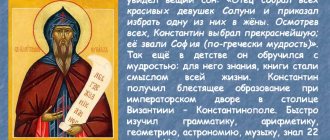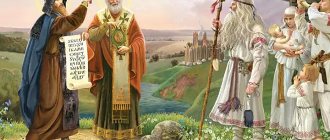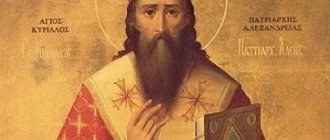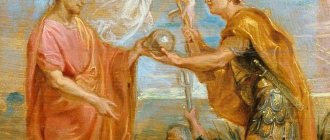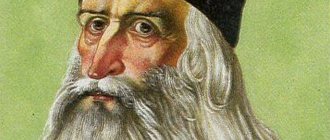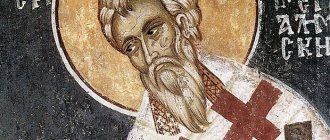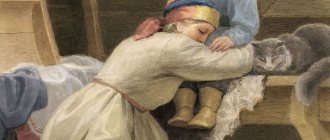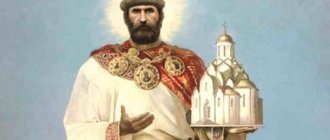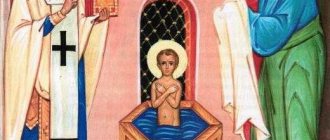Saint Cyril made a huge contribution to the development of Orthodox culture and the establishment of Christianity in the East. He was born into the family of a pious merchant in the Greek city of Thessaloniki. He was the youngest of seven children, at baptism his name was Konstantin, he received the name Cyril in adulthood, when he was tonsured a monk. Since childhood, he was distinguished by exceptional mental abilities, for which he received the nickname Constantine the Philosopher.
Saint Cyril at that time knew several languages and had knowledge in various fields of science. But the main occupation of his whole life was the creation of the Slavic alphabet together with his brother Methodius. Previously, services in Christian churches were conducted exclusively in ancient Greek and Latin. Before leaving for Macedonia in 863, the missionary brothers translated into Slavic the Lord's Prayer from the Gospel of Matthew and from the beginning of the Gospel of John, “In the beginning was the word...”.
From childhood, Saint Cyril was distinguished by his mental abilities and studied together with the young Emperor Michael from the best teachers of Constantinople, including the future Patriarch of Constantinople Photius. Upon completion of his studies, Saint Cyril was ordained a priest and appointed head of the patriarchal library at the Church of St. Sophia, but after a few years he secretly left the capital and entered a monastery.
Thanks to Saints Cyril and Methodius, the singing of the church and the gospel word immediately sounded in a language understandable to every Slav
The spiritual undertaking of Saint Cyril, who was later canonized by the Orthodox Church as the holy “Lord of Slovenia”, equal to the apostles, was of great importance for the formation of Slavic culture and writing. They distributed liturgical literature to people, the Holy Scriptures, the complete translation of which practically coincides with the original. This was the first significant step in the transfer of all religious knowledge to us Slavs.
Righteous people named Kirill
The Orthodox Church, starting from the 4th century, canonized three dozen righteous people who bore this name and lived in the territory of Byzantium, the Western Roman Empire and Russia. One of the first in this personage is Cyril, the patriarch of the Egyptian city of Alexandria. He was glorified approximately in 451. Our most famous compatriots are the Monk Kirill of Radonezh, father of Sergius of Radonezh, who took monastic vows at the end of his life, and Kirill of Belozersky. Saint Cyril is the founder of the idea of enlightened monasticism and the comprehensive social service of the church.
Most often, boys at baptism are called by an ancient Christian name in honor of St. Cyril, the enlightener of the Slavs. Each saint must have his own iconographic image. The day of celebration of the heavenly patron is called Angel Day. And the heavenly patron himself is sometimes called a guardian angel. This term is conditional and not entirely correct. This is a completely different personal non-material entity. One of the manifestations of reverence for one’s heavenly patron is prayer through his iconographic image. An icon is a window to a higher world. It should promote a person’s internal concentration.
Beware, fetishism
In reality, a completely different picture emerges. On countless websites it is offered to purchase icons of saints and the Virgin Mary with detailed instructions on what exactly this or that image helps with. Moreover, you can meet supposedly competent believers who will advise who should pray and in what cases. This reduces the sublime meaning of the icon to an ordinary object of religious cult. The reasons are both the ignorance of the clergy and the banal desire for profit: clients pay for results. In some churches you can see a price tag similar to offers in the secular service sector, offering to serve a prayer service to a saint with almost a guaranteed result: about a lost item, about a successful search for a groom, so that your teeth don’t hurt, etc. This is also facilitated by the incompetence of believers, who They identify the holy image with a medicine in a pharmacy. I bought paracetamol, swallowed it - and it became easier. A very harmful misconception that can lead to negative consequences over time. After all, fire can not only warm you, but also severely burn you. You can have huge treasures with you all your life and not be able to use them correctly. A huge number of icons will not add grace, but, on the contrary, a careless and unworthy attitude towards them can be punished. The sacred image requires appropriate veneration. You should know that prayer in front of any icon can help alleviate any trouble.
Compatibility and marriage
It is believed that Kirill can achieve a harmonious relationship with girls named Alla, Margo, Oksana, Elvira, Elena. At the same time, Kirill often remains incompatible along with Valeria, Ekaterina, Maya, Nadezhda, and Eleanor. It is noteworthy that in both cases there is some euphony when pronouncing the name Cyril with each of the listed variations. Primarily due to the presence of identical letters. By the way, the name Ksenia is not derived from Oksana, as many believe. Moreover, Ksenia is not at all a suitable match for Kirill.
Kirill's character depends on his parents
Relationships between people in marriage depend on many factors. The character of a child is largely influenced by parents and reveals positive and negative sides in him; a person is also influenced by his environment. People behave differently with people with different names. It all depends on the spiritual and mental compatibility of the persons. It is also impossible to predict the presence of unambiguous characteristics of a partner when considering the meaning of his name. It is unknown what kind of imprint was left on a person not only by his name, but also by fate along with life circumstances.
The meaning of the name Kirill suggests that its owner will become a leading member of the family. Its head. Regardless of character distortions in any direction. Therefore, a woman who is lively and conflicting by nature, who is winning equal rights with the male sex, will not suit him.
How to properly venerate icons of saints
An icon should not be treated like a book or photograph stored on a shelf that can be used from time to time. If you have acquired a holy image, then even the smallest icon requires an appropriate reverent attitude. When venerating icons of saints, you first need to study the earthly life of the archetype. This brings the inner world of a praying person closer to the heavenly patron. On the other hand, a person located in another dimension is located in a somewhat special way towards the microcosm of earthly man, who shows reverent attention to her.
Icon of the heavenly patron
You should definitely have in your house an icon of your heavenly intercessor, that is, the saint in whose honor the person is named. Don’t just store it somewhere in a sideboard behind glass, like some kind of souvenir. When looking at an icon, you should daily pray to the patron, at least briefly. It is also preferable to show attention to a righteous person close in occupation - the patron of work. For example, Saint Cyril, the enlightener of the Slavs, due to the labors he endured during his earthly life, is traditionally considered the patron saint of teachers and students. As well as an apologist for the ancient church, Patriarch of Alexandria Kirill earned the fame of a great preacher and writer. The icon of St. Cyril, the guardian angel and patron of Orthodox theologians, enjoys reverent veneration among theologians.
Where to hang
There are no prohibitions on placing a face at home. Usually it is hung in the corner of the room. It will be best if the image faces east. If this is not possible, then it’s okay. It would be better if you made a special cabinet with shelves for icons with glass, which will protect them from dust and various damages.
This cabinet is called an icon case. There should be nothing nearby, because nothing should distract from prayer. Religious believers recommend hanging the faces of saints in every room. Don’t forget about the kitchen, because prayer while preparing food will sanctify the food.
Some people think it’s not right to hang the image in the bedroom. This opinion is erroneous, because marital intimacy is not a sin at all. It is advisable to pray before going out so that your guardian angel will protect you and help you in various matters. The Orthodox prayer to the guardian angel is pronounced precisely and clearly; thoughts, desires and requests should be formulated in advance.
Your guardian angel is with you from the moment of baptism. It not only prevents you from doing bad deeds and thoughts, but also records all your good deeds and deeds. He does this in order to present them before God's court. He is also the protector of soul and body. Those who are not baptized are under the control of demons. You can be baptized at any age, as long as it was not done in childhood.
In this video you will find out who the Guardian Angel is:
Prominent Personality of the Middle East
Saint Cyril was an extraordinary church figure, and on the other hand, a typical representative of his era. The exact date of his birth is unknown. He came from a noble Greek family. In Alexandria there was a kind of dynastic continuity in the hierarchy. The beginning of the tradition was laid by Patriarch Athanasius, who was succeeded by his nephew Peter. So Cyril took the department after the death of his uncle Theophilus. According to church historian Socrates Scholasticus, Cyril’s enthronement was accompanied by mass unrest in the city. Many parties fought for the throne, including heretics. It was possible to calm the citizens only thanks to the intervention of troops. Saint Cyril was a very active person and, having settled into the pulpit, began to claim the powers of a secular ruler. Then it was the call of the times. The first Christian communities were not only engaged in preaching doctrine among non-believers and spiritually nurturing their flocks, but also carried an enormous burden of social service to society.
In the 5th century, the Church struggled with numerous heretical teachings. By order of Cyril, all Novatian parishes in Alexandria were closed. Contemporaries testify that Saint Cyril not only waged an uncompromising fight against heresies and remnants of pagan ideology, but was also distinguished by aggressive anti-Semitism. The persecution of the Jews led to clashes with the Roman governor Orestes. The authority of the Egyptian See allowed the Patriarch to openly fight the heresy of Nestorius, who in 428 took the See of Constantinople. It was on the initiative of Cyril that the Third Ecumenical Council was convened, which approved the veneration of the Blessed Virgin Mary. He ruled the local Church of Alexandria for 32 years and died in 444. Cyril wrote many dogmatic treatises. The most outstanding exegetical works are interpretations of the books of the Old Testament prophets, the Gospel of Luke, John the Theologian and the epistles of the Apostle Paul.
Life of Cyril the Wonderworker
Kirill Novozersky was born in Galich. Even in his youth, having hidden it from his parents, he went to a monastery in the Vologda forest. On the way, he met a mysterious elder, from whom he received a blessing to travel to the monastery of St. Cornelius. The elder disappeared after the blessing.
Upon arrival, Kirill took monastic vows. His parents despaired of looking for him and decided that he was dead. However, Kirill's father found out the location of his son through one monk. Arriving at the monastery, he did not recognize Kirill, so he had changed. My father also took monastic vows. Before his death, his mother also accepted him.
After the death of his father, Kirill did not keep anything of his property for himself; he gave everything to those in need. He went north into the deep forests, where he began to live in complete solitude. He ate sparingly; the only food he had was plants and tree bark. Sometimes he left his solitude, but only to pray in holy places.
Realizing that his health was beginning to fail and his strength was leaving his body, Kirill began to pray to God. He asked to indicate a place where he could live out his years. Intense prayers showed the way to Beloozero. In a dream, he saw an angel who pointed him to the Red Island. The ascetic purchased the island and built two churches and a cell there. Here he received the priesthood.
It was hard for Kirill. Every now and then they tried to rob his church. One day the bell was removed altogether. But on the holy land the thieves could not finish what they started. They got lost in the forests or surrendered under the pressure of Cyril’s high morality. The ascetic, in turn, although he denounced the thieves, treated his trials with great love and patience. He fed the thieves who stole the bell and sent them away in peace. They say they didn't steal anymore.
Kirill had a strong character. He looked after the farm himself, dug the ground, cut wood. He was not stopped by severe frost and wind. He refused any benefits and did not indulge himself.
One day, his student said that during a service he saw a deacon praying nearby, who then seemed to disappear into thin air. Kirill did not allow anyone to tell about such a miracle.
The elder’s prayers saved one prince from certain death. The prince, in turn, thanked Kirill with generous gifts in the form of rye, butter and salt.
Kirill died on 02/04/1532. Before his death, he predicted the future of the Russian land. He announced that there would be rebellion and troubles in the lands, but God would establish peace and a kingdom on earth.
Even after death, he came to the monks in their dreams and healed them of illnesses.
The elder’s relics are laid in the temple, which was built by the boyar Morozov.
The saint's memorial days are celebrated on July 7, November 20, February 5 and 17.
Iconographic image of Cyril of Alexandria
The tradition of Christian painting has ancient roots of Syro-Palestinian origin. It is customary to depict saints on icons in accordance with the way of their earthly life. As a rule, a pictorial image is created at the time of the canonization ceremony. Sometimes more than a dozen years pass between the death of a righteous person and his canonization, and the image on the icon may not quite correspond to the portrait likeness. Unfortunately, due to the iconoclastic heresy that raged in the 8th century on the territory of Byzantium, many ancient icons were irretrievably lost. The most ancient images depicting the great patriarch of Alexandria, Saint Cyril, have not survived either. The modern icon depicts the saint in liturgical vestments corresponding to his episcopal service. An obligatory detail of the composition is the Gospel in the hands. In accordance with the iconographic tradition, emphasizing the reverent attitude towards the Holy Scriptures, the saint holds the book not with an open hand, but through the fabric of his vestment.
Meaning of the name Kirill
The meaning of the name Kirill comes down to the concepts of “lord”, “master”, etc. However, such characteristics should not be associated with the term about people in power, whom we represent in high official political positions. The initial semantic load here is somewhat different and, so to speak, more positive. The name Cyril, which has Greek roots, came to the territory of Rus' from Byzantium. According to the information of the Soviet linguist A. Nikonov, known throughout the USSR, the name spread primarily within the city limits. For the villagers it was strange and unusual. The name remained rare until the end of the 20th century. Gained great popularity in 21st.
Popularity of the name Kirill among native Russians
Saints Athanasius and Cyril of Alexandria
The memory of Saint Cyril, Patriarch of Alexandria, is celebrated on June 22 according to the new style. However, the church established another veneration - January 31. On this day, the triumph of Cyril is celebrated together with another outstanding teacher of the church, his predecessor at the department, Athanasius of Alexandria. The joint celebration is determined in memory of recognition of their merits and exploits in defense of the dogmatic teaching of the Church. Saints Athanasius and Cyril are two great representatives of the Alexandrian theological school. Their works are important not only for intra-church use, but are also very relevant for sociologists, historians and psychologists.
Derivatives of the name Kirill
Most derivatives have the meaning of diminutive nicknames. According to some parents, they sound somewhat unrespectable. Examples here include Kirya, Kiryusha, Kiryunya, Kiryukha, etc. From the sound of these unofficial pseudonyms, it is difficult to imagine that the standard form is associated in meaning with dominance and power.
As for variations with the spelling of the direct name Kirill, the presence of a double letter “l” is considered correct. Although in fact this is not regulated in any way, so parents can name the baby whatever they want.
Apostle of Eastern Europe
The greatest contribution to the culture of our fatherland was made by two brothers, Cyril and Methodius. Before taking monastic vows, Saint Cyril, Equal to the Apostles, bore the name Constantine. He and his brother Methodius came from a pious Slavic family. Their father was a military leader in the Greek city of Thessaloniki (modern Thessaloniki). Constantine received an excellent classical education at the emperor's court, for which he received the nickname of a philosopher. They became famous in connection with their unprecedented efforts to educate the East Slavic tribes. For the effective impact of Christian preaching, they compiled and put into circulation a new alphabet for Slavic tribes speaking related languages. After one of the creators, this monument was named Cyrillic. The brothers translated many liturgical books and the Gospel into Slavic. In order to be able to perform divine services in a dialect understandable to the Slavs, Constantine was ordained a bishop. Shortly before his death in 869, he accepted the monastic rank.
It should be noted that the clergy of the Russian, Serbian, Bulgarian and some other East Slavic churches have been using the original writing for more than a millennium. And if the modern languages of related peoples are already difficult to understand for each other, then the language of worship is absolutely identical. The feat of preaching activity of Constantine-Cyril is equated by the church consciousness with the feat of the apostles, therefore, during canonization, the saint was given the title “equal to the apostles”, and the days of celebration were not set on May 24 and February 27. In every Orthodox educational institution, in a place of honor there is an icon of St. Cyril, the guardian angel and patron of students and teachers.
On May 24, the Orthodox Church celebrates the memory of the holy Equal-to-the-Apostles brothers Cyril and Methodius, Slovenian teachers, who are considered the creators of the Slavic alphabet and literary language.
The annual holding of the Days of Slavic Literature and Culture led to the appearance of numerous and varied images of the Solunsky brothers. This includes traditional icon painting techniques, sculpture, and various graphic images. But before we begin the story about the images of the holy brothers, let us pay attention to what the Church considered important in their lives and works. It is well known that their veneration began soon after their repose. Contemporaries did not doubt the sanctity of Cyril's life; Already in the materials collected by his brother after his death, there is undoubted evidence of his holiness, in particular, that the Slavic alphabet was received by him as a revelation of God. The universal recognition of the saint was confirmed by the writing of the icon placed above his tomb. The Life of Methodius, compiled in the decades closest to his death, contains the first text that has a liturgical sound - this is the final address of the life, reminiscent of a troparion: But you, holy and honorable head, looking down upon us with your prayers from above, who have loved you, deliver us from every misfortune our disciples, and spreading the teaching, and driving away heresies, and having lived here worthy of our title, we will stand with you, your flock, at the right hand of Christ our God, receiving eternal life from Him, for to Him be glory and honor forever and ever... The most ancient surviving sources contain references about “our reverend father Constantine the Philosopher, named in the monkhood by the name of Cyril” (quite often) and Methodius, Bishop of Moravia (less often). These are the month books of the Ostromir and Assemanian Gospels, the month books of the Apostle from the Ohrid Monastery and others. The first liturgical texts were compiled by the disciples of the Equal-to-the-Apostles brothers back in Moravia. The Praise and Service to Saint Cyril celebrates his virtuous life, zeal for holy icons, and missionary work. The saint's role in the enlightenment of the Slavic world is noted, but only along with his other educational exploits; he is compared with the Apostle Paul, and is not an educator of any one people. His merits in the creation of the Slavic alphabet are noted, but mainly he is praised for his writings (theological conversations). The service, compiled shortly after Methodius’s repose, calls him “the great shepherd of the Slavs.” After the expulsion of the disciples Cyril and Methodius from Moravia, already in Bulgaria, they glorified the holy brothers primarily as educators of the Slavs. The liturgical texts of this time emphasize that Slavic writing is sacred, revealed to Cyril by God Himself. This aspect of the activity of the holy brothers is especially clearly emphasized during the reign of the Bulgarian kings Boris and Simeon. Soon after the Baptism of Rus', the veneration of the Thessalonica brothers begins here; This is already evidenced by our first chronicle - “The Tale of Bygone Years.” It is interesting that in the narration of the Russian chronicler, the role of Methodius in the creation of the alphabet is greater than that of Cyril.
And in Bulgaria in the 10th century, the veneration of the brothers equal to the apostles steadily increased in both spiritual and cultural life; the holy brothers became for the Bulgarian Church its spiritual forerunners. Ohrid's Hagia Sophia Cathedral was rebuilt and re-painted in the mid-11th century. Archbishop Leo of Ohrid drew up a program for painting the temple, and it was thanks to him that images of Slavic hierarchs - Equal-to-the-Apostles Clement of Ohrid and Cyril the Philosopher - appeared in the lower tiers of the painting of the altar and altar. It is believed that the fresco is from the 11th century. in the Ohrid Church of St. Sophia is one of the earliest known images of Equal-to-the-Apostles Cyril. Unfortunately, its preservation is poor.
There is a mention that outside the Slavic world, in the Roman Basilica of St. Clement of the 9th century, there was an image of Equal-to-the-Apostles Cyril. These images date back to the 11th century. Their appearance in the Church of St. Clement is associated with the discovery by the Equal-to-the-Apostles brothers in Chersonesos of the venerable relics of the Holy Martyr Clement, Pope of Rome, during their missionary journey to Khazaria. On the walls of the temple of St. Clement, not only the transfer of his relics by the holy Thessalonica brothers is depicted, but also their trial. This last scene depicts the holy brothers kneeling before the Savior, and two angels, the Apostle Andrew and the Hieromartyr Clement, testifying in defense of the Slavic enlighteners.
In connection with the last topic, it seems appropriate to pay attention to a monument of Czech literature of the 10th century, known under the code name “Christian’s Legend”. It is a story about the first Czech saints - Cyril and Methodius, Vyacheslav and Lyudmila. This narrative began with a story about the activities of Cyril and Methodius, who converted the population of Great Moravia (St. Cyril) and the Czech Republic (St. Methodius) to Christianity, and it was noted that Cyril was a Greek by birth, who knew Greek and Latin writing well. An important place in this story is occupied by the topic related to the creation of Slavic writing. It talks about Cyril’s creation of the Slavic alphabet, the translation from Latin and Greek into Slavic of the Old and New Testaments and “many other” texts, the performance of services in the Slavic language and the conflict that arose in this connection between Cyril and the Latin clergy. The story ends with the words that Cyril managed to convince the Pope that he was right, proving that only in this way could he introduce such wild people and “who do not know the ways of God” to Christianity.
There is an assumption that in Hagia Sophia of Ohrid, next to the image of the Slavic apostle Cyril and Clement of Ohrid, another Slavic apostle, Methodius, was presented, whose face was covered by a later layer of frescoes. Another remarkable image of Equal-to-the-Apostles Cyril has been preserved in a small church near the capital of Bulgaria; it dates back to the 14th century. This period - from the beginning of the reign of Ivan Alexander (1331) to the conquest of the Tarnovo kingdom by the Ottoman Turks (1393) - is considered the “second golden age” of Bulgarian culture. The skill of provincial craftsmen of this period goes back to the best examples of the “Palaeologian Renaissance”. The paintings of the church in the village of Berende, located near the town of Godech (Sofia district), date back to this time; In these paintings, of particular interest to us is the image of revered saints, among which is the well-preserved Equal-to-the-Apostles Cyril. The saint is depicted in polystaurium, in his hands he holds a scroll with the text: Bless those who bless Thee and sanctify those who trust in Thee... The image is inscribed “St. Cyril the Philosopher.” It is believed that the Slavic enlightener Constantine-Kirill was awarded the title “Philosopher” most likely due to the fact that he was a philosophy teacher at the Magnaur School in Constantinople. In the preface to his lengthy life he is called “Constantine the Philosopher.” Already in early liturgical literature, in connection with his canonization with the name (in the schema) Cyril, he is called Cyril the Philosopher, for example, in the monthly book of the Assemanian Gospel of the 11th century, in the Menaion April of the 11th-12th centuries, in the Triodion of Grigorovich of the 12th-13th centuries, in the Synodikon "Boriloviya" of the 13th century.
In Rus', the veneration of the holy Slavic enlighteners was known already in the 11th century; The oldest services to them that have survived to our time date back to the 13th century. Few ancient images of saints have survived. In the Cyril Monastery in Kiev, frescoes around 1170, perhaps influenced by Macedonian artists, depicted a number of saints who were especially revered in Macedonia and Thessaloniki: Saints Cyril, Methodius, Clement of Ohrid, John the Great, Joseph of Thessalonica.
A cycle of miniatures depicting the saints Equal-to-the-Apostles Methodius and Cyril is contained in the Radziwill Chronicle, created at the beginning of the 15th century and containing the initial history of Ancient Rus' from its origins to 1206. The original Radziwill Chronicle (named after the last owner), which ended up in the Koenigsberg Library in the mid-17th century, returned to Russia as a trophy of the Seven Years' War in 1761. Since 1818, the manuscript has been kept in the Library of the Academy of Sciences (BAN) in St. Petersburg . Among the 613 miniatures of this chronicle, there was also a place for the depiction of Slavic enlighteners. The entire text of the Radzivilov Chronicle is Russian, and not translated from Greek; its initial part is “The Tale of Bygone Years”. The text of the chronicle, and after it the content of the miniatures, cover mainly the political history of Rus'. Hence the predominance of images of battles, military campaigns, princely negotiations, embassies, etc. However, there is present here and with a certain consistency, declarative clarity, another, as if parallel, aspect of history is revealed - the Christian one. Moreover, Rus', in accordance with the concept of the compilers, from the first pages of the narrative, appears as an integral part of the general Christian world, initially associated with the apostolic sermon addressed to it and the prophecy about it. Following the miniatures, in which the “Sermon on Law and Grace” of the Kyiv Metropolitan of the mid-11th century Hilarion seems to receive a visible embodiment (speaking of the original involvement of Rus' in world Christianity), begins a cycle of miniatures dedicated to the missionary activities of the holy Equal-to-the-Apostles Slovenian teachers, Constantine-Cyril and Methodius. This cycle is programmatic in nature. In accordance with the text of the “Tale of Bygone Years,” the presentation of the activities of the holy brother-enlighteners of the Slavs follows as an inserted episode after the enumeration of the peoples conquered by the Ugrians under 898. The mention of the Moravians in this series gives the author of the chronicle the reason for the following entry: Simultaneously, the book of the world was first translated, even nicknamed the Slovenian charter, which also exists in Rus' and among the Danube Bulgarians... Next comes the news of the embassy of baptized Slavic princes to Emperor Michael III (842-867), returning the reader of the chronicle to the history of the creation of the Slavic charter. The cycle of miniatures opens with a scene of the council of the Byzantine emperor with philosophers in Constantinople (left) and a scene of a conversation between the imperial envoy and the father of the holy brothers Leo in Thessaloniki (right), combined into one miniature (No. 30). Below on the same sheet of manuscript is presented, also double, the scene of the creation of “alphabet Slovenian letters” and at the same time the translation into Slavic of the Gospel, the Apostle, the Psalter and the Octoechos (No. 31) - and “the transposition of the Apostle and the Gospel” and, the chronicler adds, “rad The Slavs were like hearing the greatness of God with their tongue.” Then, the chronicler continues, the brothers “translated the Psalter, Octoechos and other books.” Visually, the act of creation is miraculously instantaneous. In the process of working on the design of the manuscript, the miniature underwent serious alterations; traces of them are clearly visible. As a result, the illustrators chose the most traditional option in the form of the usual “author’s” portraits. And although the very text of the invented “alphabet” is presented extremely schematically, the sublime nature of the brothers’ work is obvious. On the reverse of the same sheet is a miniature (No. 32) depicting the installation of Saint Methodius by Pope Adrian II in 869 as Bishop of Pannonia. This scene is a kind of culmination of the cycle. Its triumphal character (also within the framework of the iconographic canon) makes obvious the great merits of the enlightener-hierarch who inherited the apostolic see. This series is completed by a miniature (No. 33), which is usually interpreted as a scene of the ongoing educational activities of Saint Methodius - his translation of books from Greek into Slavic and their correspondence by two cursive writers. This interpretation actually corresponds to the text of The Tale of Bygone Years, recorded on fol. 13 vol. Radzivilov Chronicle. However, the nature of the paired scenes that make up the miniature allows us to raise a number of questions. First of all, because all three characters have halos, and this is unexpected: in the previous miniature only Methodius himself and Pope Adrian II are equipped with halos. It is possible that what we see on the left is the actual copying of books by order of Saint Methodius. On the right is a “portrait” of St. Cyril in the form of a monk who took monastic vows shortly before his death. At the same time, it is permissible to believe that Cyril is also presented on the right in the previous scene, but as a copyist. In other words, miniature No. 33, as it were, summarizes the activities of the brothers, giving the image - with all its innocence, if not primitiveness, an equally triumphant character. The activity of the brothers here is likened, with quite clear iconographic parallels, to the feat of the holy fathers - the creators of the Liturgy.
It is appropriate here to quote the words of another chronicler (from the Novgorod Chronicle of the older edition): A wise man, without a book, is like a stronghold standing without supports, if there is wind, he will fall... - the Novgorod chronicler included these words of St. Ephraim the Syrian in his chronicle not by chance : in the Orthodox consciousness of Ancient Rus', wisdom was inextricably linked with the book. It was as the founders of Slavic literature that our ancestors revered the Solunsky brothers.
By the time the iconographic originals were created, the iconography of Saints Methodius and Cyril almost lost connection with their early images, which is clearly seen from the text below: \\\\\\\"May 11th - Saints Equal-to-the-Apostles Methodius and Constantine, monastically Cyril, Slovenian teachers : like Bulgarian Slavs. St. Constantine, in the schema Cyril - middle-aged, i.e. 42, with a more than average-sized, full beard and forked at the end, streaked with gray; you can write him as a bishop in phelonion and omophorion; and as a schema-monk in a schema, in a mantle with tablets; in his hands is a charter with the inscription of his sayings: \\\\\\\\"God created man, between heaven and earth, between angels and beasts, with reason, for with sense separated him from the beasts, with anger and lust separated him from the angels, and gave free will , but the hedgehog wants, creates, and approaches, he will find himself: or he will turn out to be an angel, working for God, as his enlightened mind will do; or the companion becomes a foolish beast, working with carnal lusts without self-restraint."
You can write it with the book of the Gospel. He died in 869.
Saint Methodius is the elder brother of Saint Cyril: an old man, gray-haired, with a large but narrow beard; hair is not long, in phelonion and omophorion; in his hands is a book with the letters: A, B, C, - since he invented the alphabet and literacy for the Slavic language. You can write him a charter, based on his life: \\\\\\\"I have destroyed that entire country, and strengthened and assured all the people, and driven away the Jews\\\\\\\." Or: \\\\\\\"Like an elegant fighter, with prophetic words and apostolic sayings, like a warrior shooting with both hands at the Jews, and at the heretics, and at them." Died in 885\\\\\\\".
Turning to the images of the Slavic enlighteners, when creating a new iconography, one should undoubtedly take into account not only the general recommendations of the iconographic originals, but also the inextricable spiritual unity of the Equal-to-the-Apostles brothers with universal Orthodoxy, which the authors of their early images tried to show - both in the painting of churches and in books miniature.
In the handwritten Menaion of the late 16th century from the collection of the Sofia Library (RNB) there is a remarkable note made by the scribe: \\\\\\\"The servant of God Timothy wrote this book - my hand, our letter\\\\\\\." At all times, Slavic writing was, is and will be ours, that is, spiritually uniting the people of the Slavic world - and not only the Slavic, the entire Orthodox world - culture, history and, of course, faith. And at the origins of our writing we see the Equal-to-the-Apostles brothers of Thessaloniki, and, without having a portrait image of them, we clearly imagine their spiritual appearance.
Sources and literature: Angelov D. Kiril and Methodius and Byzantine literature and politics. - Hilyada and hundred godini Slavic pismenost. Sofia. 1963. Antonova V.I., Mneva N.E. Catalog of Old Russian painting of the 11th - early 18th centuries. (State Tretyakov Gallery). T.1-2. M., 1963. Artsikhovsky A.V. Old Russian miniatures as a historical source. Tomsk-M., 2004. Bakalova E. Paint murals on the tsarkvata near the village of Berendey. Sofia, 1976. Vasiliev As. Image Cyril and Methodius into something alien and find fine art. - Hilyada and hundred godini Slavic pismenost. Sofia. 1963. Granstrem E.E. Why was Metropolitan Kliment Smolyatich called \\\\\\\\"philosopher\\\\\\\\". - TODRL, vol. 25. Grozdanov Ts. Portrait of Kliment Ohridski in medieval times. — Slovenska pismenost. Ohrid, 1966. Djuric V. Byzantine frescoes. Medieval Serbia, Dalmatia, Slavic Macedonia. M., 2000. Lazarev V.N. History of Byzantine painting. T.1. M., 1986. Podobedova O.I. Miniatures of Russian historical manuscripts. On the history of Russian facial chronicling. M., 1965. Popov G.V. The theme of Slavic enlightenment in miniatures of the Radzivilov Chronicle. — Old Russian art. Byzantium, Rus', Western Europe: art and culture. St. Petersburg, 2002. Takhiaos A-E.N. Holy brothers Cyril and Methodius, educators of the Slavs. Sergiev Posad, 2005. Florya B.N. Christianity in the Old Polish and Ancient Bohemian states in the second half of the 10th - first half of the 11th century. — Christianity in the countries of Eastern, South-Eastern and Central Europe on the threshold of the second millennium. M., 2002. Florya B.N., Turilov A.A., Ivanov S.A. The fate of the Cyril and Methodius tradition after Cyril and Methodius. St. Petersburg, 2000. Harisijadis M. Miniatures and ornaments of Octoechos r.64 in the Gradsk Library near Zagreb. — Collection on the face of skill. Novi Sad, 1968, building 4. Cirkovic S. Serbia. Middle Ages. (Slavic-Byzantine arch). M., 1996.
.
NIKOLAI POGREBNYAK. Cyril and Methodius in iconography.
https://artpolitinfo.ru/kirill-mefodiy-v-ikonografii/
Images of the enlightener of the Slavs
Artistic images of the great teacher are widespread. In Orthodox churches in Eastern Europe you can find authentic frescoes depicting St. Cyril. The icon has several canonically approved versions. Constantine-Cyril is most often depicted in the vestments of a monk-schema. He took monastic vows of particular severity - the schema. When written together by two enlightenment brothers, Cyril is depicted only in monastic vestments. Since the saint was ordained, there are icons where he is depicted in the liturgical robes of a bishop. Invariably, in the hands of the saint there is either a scroll with the Slavic alphabet or an open book, most often the Gospel of John with the first lines of scripture. Kirill died when he was 42 years old. In modern tradition, he is depicted at approximately this age. On the few surviving ancient icons, the Slavic guardian angel Saint Cyril is represented as an old man with a rather long beard, forked at the end.
Name day day
The Primate of the Russian Church, His Holiness Patriarch of All Rus' Kirill, took this name during his monastic tonsure. A new name is given as a sign of renunciation of the past life and the beginning of a new, ascetic one, subordinate to completely different ideological principles. At the same time, the enlightener of the Slavs, Saint Cyril, became the heavenly patron of the future hierarch in monasticism. The Patriarch of Moscow sets an example of reverence for his heavenly patron. According to Christian canons, on the day of your Angel you should certainly partake of the Holy Mysteries of Christ. On May 24, the Orthodox world celebrates the holiday of Slavic literature and culture. On the day of his heavenly patron, His Holiness Patriarch Kirill obligatorily celebrates the Liturgy, if possible in a church dedicated to the saint. Also, every believer bearing the name Cyril, if he really wants to honor his heavenly patron, must take part in public worship on this day or at least go to the temple to light a candle.
Character fate
It is difficult to identify unambiguous features characteristic of each bearer of this name. After all, each of us forms our own character based on the conditions of growing up, that is, socialization. Much, as already mentioned, depends on the values invested by the parents. But it is believed that such people are characterized as purposeful and enjoying life, as well as the people around them. The main thing is to help reveal these positive characteristics during the period of raising a child. If parents make the wrong steps, the baby can develop excessive self-confidence and selfishness.
Kirill can occupy leadership positions
As for the field of activity, Kirill is capable of doing a variety of things. At the same time, he can easily be responsible for work and people in leadership positions or even create his own business. Without depending on the employer.
Spiritual conversation
Regardless of whether a person believes or not, the laws of the spiritual world apply. An analogy can be drawn with the laws of physics. Even if a person has never heard of Newton's law and the acceleration constant of gravity, universal gravity operates, and those who ignore it can suffer greatly. The world of metaphysics is still waiting for its researchers and discoverers, but for now we should listen to the thousand-year experience of the church. Appeal to the saints is usually called prayer. There are canonical prayers for liturgical use, which believers can also use at home. In prayer to St. Christians turn to Cyril of Alexandria as an assistant in the defense of all truth and piety. Preserving and spreading the faith is impossible without preaching. The success of a speaker is based on talent, comprehensive education and dedication. This is how Saint Cyril, a guardian angel, appears in the church consciousness for all those striving for enlightenment. The prayer to the righteous Equal-to-the-Apostles expresses requests for help in overcoming fraternal discord between peoples and preserving fatherly traditions and traditions.
